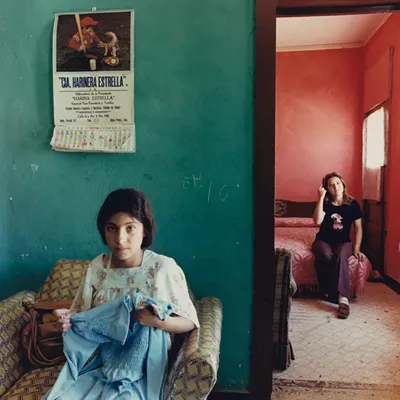When Gwyneth Scally got an artist's residency in Newfoundland two summers ago, she was mesmerized by the stark white icebergs off the coast.
Each year, in late spring and early summer, building-sized icebergs "calve"—break off—from the gigantic ice sheet encircling Greenland and drift west toward Canada's eastern shores. Anywhere from 400 to 800 icebergs turn up in the Labrador current, and tourists flock to see them.
Scally was as delighted as anyone to find the ice masses floating in the sea. She's lived in desert Tucson for many years, and before that, she went to college in the steamy South. But she also found that not all is well in the frozen North. A NASA study from 2006 raised the alarm: Global warming has been speeding up the melting of the 2-mile-thick Greenland ice sheets. The great ice shelf is dwindling.
So Scally's project took a turn toward environmentalism; she created works not only about the potential loss of the ice shelf and the pine forests of the North, but about humans' skewed relationship to nature. This month, she's exhibiting paintings and sculptures in The Forest, a one-person show at Conrad Wilde Gallery, and an installation in the MFA show at the UA's Joseph Gross Gallery. (She'll be awarded her master's degree this weekend.) Both bodies of work "address the loss of cold, northern climates in our world," she writes.
All the sculptures at Conrad Wilde look like souvenir log plaques, the kind a tourist might pick up to remember a visit to the icy realms. Made of fiberglass molded and cast to look like round slices of log, complete with raggedy bark, each one is painted icy white. And each one has a tiny painting on its flat surface.
"Newfoundland Coast #2" pictures the landscape the way it ought to be. The little circular painting on the fake log shows a pointy iceberg out at sea. It's framed by healthy pines on shore. The mini-painting in another small sculpture, "The Overpass," is more sinister. An iceberg has been forced so far off its natural course that it sits atop a highway overpass. Below, a road's blacktop shoots off toward the horizon. Don't look for any wilderness here.
Eight mixed-media canvases, combining oil paint and graphite, showcase Scally's considerable skill at drawing. She's hyper-gifted at realistic rendering, and she puts that talent to work here in paintings of human figures set in haunted northern landscapes. Most often, she sketches in the people with pencil and overlays them with muted color in a limited palette, subdued pink, say, or brown. She reserves her thickest paints for the sweeping terrain.
In "On Tour; Music for the North," a 2009 oil, enamel and graphite on canvas, two figures stand in a field of white; silhouetted pine trees in ocher and white line the horizon beneath a deep amber sky. The big man, in a fur hat and snowsuit, lifts aloft a pine trunk stripped of branches and bark. A woman stands behind him, and holds her piece of dead tree loosely in her hands.
The strange warm colors of the trees and sky, closer to fire than ice, hint at the Armageddon to come. The figures, meanwhile, are indifferent. Flailing away with his log, the man has a face that's strangely impassive.
In "Facing North," an oil and graphite on canvas, a different man seems more attuned to the place. He has a fur hat, too, but he raises his wrapped head in concentration, engrossed in trying to understand this place. The sky is flat and gray, with hints of blue. The pines this time are brown—simplified stick drawings. Scally allows herself some wild brushstrokes on the earth. The snow is gone, and the mud left behind is ocher and brown.
Scally is particularly good at conjuring the big spaces and silences of the North, breaking the landscape down into simplified shapes and subdued colors. Her humans are oddly ill-suited for this terrain, though. They don't exactly inhabit the land. Instead, they float above it, strangely unhinged. The woman in "On Tour" has no feet; her legs taper into nothingness.
In "My Father Camping," 2009, an oil and graphite on canvas, the dad sits cheerfully in front of a tent in the wilderness, with a coffee pot. He hovers above the earth, of it but not in it, exactly. The same goes for the scientist doing an autopsy of Mount Lemmon in "Forensics for the Pine Forests." His feet don't touch the ground.
The installation over at Joseph Gross, "Museum of Dying Giants," 2009, holds humans accountable for the losses in the land. A big white fur tent—meant to invoke the polar bears, perhaps, and their dwindling habitat—is home to an entire pine forest. Underneath the fur, inside the tent, the pines are dying. Off on the horizon, the icebergs are vanishing.
Scally doesn't let the desert-dwellers in her adopted landscape off the hook, either. A few of her works are about poor Mount Lemmon, whose forests have been ravaged by fire twice this decade and are now being consumed by bark beetles. Both disasters can be traced to human depredations, scientists believe; suppression of natural fire and overgrazing of the original grasses on the forest floor have left the trees vulnerable.
(For proof that we've damaged our beloved mountain, look at the historic photos of the lush woods of the early 20th century in Mary Ellen Barnes' book The Road to Mount Lemmon, published by the University of Arizona Press.)
Scally tackles the tree trauma in oil and graphite on canvas. In "Forensics for the Pine Forests," 2009, a row of dead ponderosa pines stands along a steep ridge. A forester sketched in pencil and painted in pale pink crouches down to hear the verdict from the medical examiner in suit and tie: The scientist can do nothing for his patients. You can almost see him shaking his head. In his hands, he holds a pinecone in a box, a tiny coffin for a dead forest.
Beyond these figures is the familiar cascade of lovely peaks: It's still beautiful up there. But painted a subdued bottle green and silhouetted in spectral white, the trees are the ghosts of forests past.
The Forest
Works by Gwyneth Scally
11 a.m. to 5 p.m., Tuesday-Saturday, through May 30
Conrad Wilde Gallery
210 N. Fourth Ave.
Free
622-8997; website
2009 Master of Fine Arts Thesis Exhibition
9 a.m. to 4 p.m., Monday-Friday, through May 15
UA Joseph Gross Gallery
Southeast corner of Park Avenue and Speedway Boulevard
Free
626-4215; website










